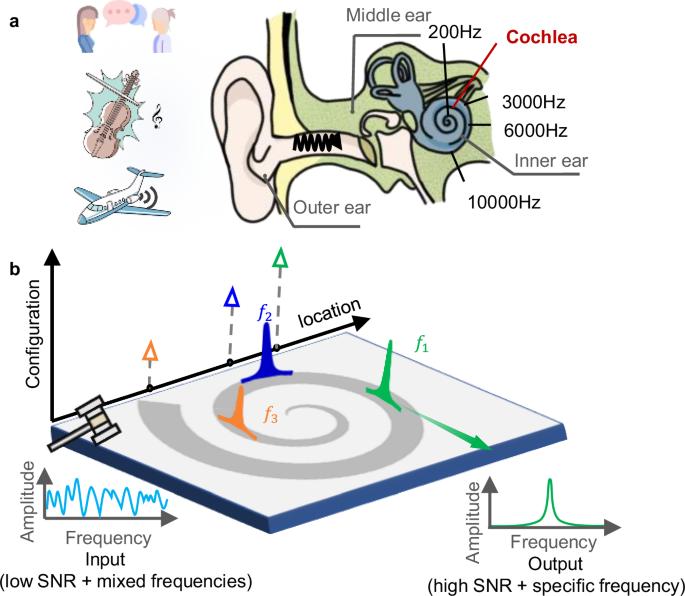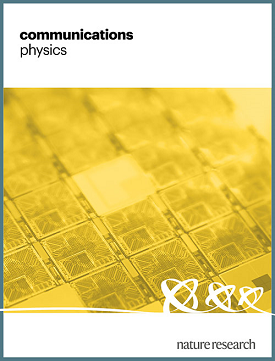Separating, purifying and decoding elastic waves by mimicking a cochlea on a thin plate
IF 5.4
1区 物理与天体物理
Q1 PHYSICS, MULTIDISCIPLINARY
引用次数: 0
Abstract
A human cochlea is capable of continuously separating and amplifying sound of different frequencies to specific positions from 20 to 20,000 Hz, which makes it a high-resolution living sensor. The realization of cochlea-like structure for elastic waves in solids offers a highly desirable functionality on high throughput mechanical energy harvesting and sensing, but remains a challenging topic owing to narrow band and intricate configuration. Here we propose and demonstrate a generic framework of elastic cochlea on a thin plate, enabled by a pair of compact metafence layers. It is experimentally realized to harvest and separate flexural waves in quite a wide frequency range from 5.8 to 21.8 kHz, together with a continuous energy amplification exceeding one magnitude order. An enhanced mode, characterized by a near zero group velocity at a tailored cutoff width, is uncovered to illustrate the filtering and amplification physics. Moreover, complex information demultiplexing and undistorted decoding are further realized by harnessing the high-Q signal sensing and purification. The proposed prototype may stimulate substantial applications on information processing, non-destructive evaluation and other wave regulation scenarios. Cochlea is a high-resolution auditory transduction organ to distinguish sounds in both high sensitivity and broadband working frequency. The authors mimic a cochlea on a plate, which can separate, purify and decode complicated elastic waves in quite a compact way.

通过在薄板上模拟耳蜗分离、净化和解码弹性波
人类耳蜗能够连续分离和放大 20 至 20,000 Hz 不同频率的声音到特定位置,这使其成为一个高分辨率的活体传感器。在固体中实现类似耳蜗的弹性波结构,为高通量机械能采集和传感提供了非常理想的功能,但由于频带狭窄和配置复杂,这仍然是一个具有挑战性的课题。在这里,我们提出并展示了一个薄板弹性耳蜗的通用框架,通过一对紧凑的元栅栏层来实现。实验证明,它能在 5.8 至 21.8 千赫的宽频率范围内收集和分离挠性波,并能持续放大超过一个量级的能量。为了说明滤波和放大的物理原理,还揭示了一种增强模式,其特点是在定制的截止宽度下群速度接近零。此外,通过利用高 Q 值信号感应和净化,还进一步实现了复杂信息的解复用和无失真解码。所提出的原型可能会在信息处理、无损评估和其他波形调节场景中得到大量应用。耳蜗是一种高分辨率的听觉传导器官,能以高灵敏度和宽带工作频率分辨声音。作者在平板上模拟了耳蜗,它能以相当紧凑的方式分离、净化和解码复杂的弹性波。
本文章由计算机程序翻译,如有差异,请以英文原文为准。
求助全文
约1分钟内获得全文
求助全文
来源期刊

Communications Physics
Physics and Astronomy-General Physics and Astronomy
CiteScore
8.40
自引率
3.60%
发文量
276
审稿时长
13 weeks
期刊介绍:
Communications Physics is an open access journal from Nature Research publishing high-quality research, reviews and commentary in all areas of the physical sciences. Research papers published by the journal represent significant advances bringing new insight to a specialized area of research in physics. We also aim to provide a community forum for issues of importance to all physicists, regardless of sub-discipline.
The scope of the journal covers all areas of experimental, applied, fundamental, and interdisciplinary physical sciences. Primary research published in Communications Physics includes novel experimental results, new techniques or computational methods that may influence the work of others in the sub-discipline. We also consider submissions from adjacent research fields where the central advance of the study is of interest to physicists, for example material sciences, physical chemistry and technologies.
 求助内容:
求助内容: 应助结果提醒方式:
应助结果提醒方式:


